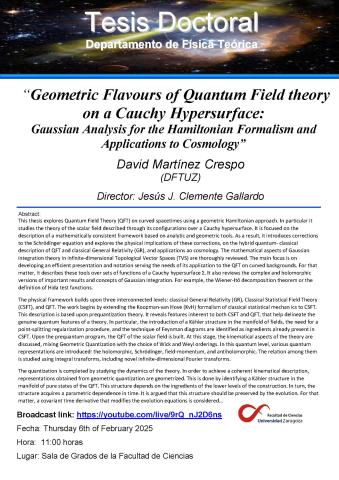Tesis doctoral. David Martínez Crespo (DFTUZ)

Title: Geometric Flavours of Quantum Field theory on a Cauchy Hypersurface.
Subtitle: Gaussian Analysis for the Hamiltonian Formalism and Applications to Cosmology.
Abstract:
This thesis explores Quantum Field Theory (QFT) on curved spacetimes using a geometric Hamiltonian approach. In particular it studies the theory of the scalar field described through its configurations over a Cauchy hypersurface. It is focused on the description of a mathematically consistent framework based on analytic and geometric tools. As a result, it introduces corrections to the Schrödinger equation and explores the physical implications of these corrections, on the hybrid quantum- classical description of QFT and classical General Relativity (GR), and applications ao cosmology.
The mathematical aspects of Gaussian integration theory in infinite-dimensional
Topological Vector Spaces (TVS) are thoroughly reviewed. The main focus is on developing an efficient presentation and notation serving the needs of its application to the QFT on curved backgrounds. For that matter, it describes these tools over sets
of functions of a Cauchy hypersurface Σ. It also reviews the complex and holomorphic versions of important results and concepts of Gaussian integration. For example, the
Wiener-Itô decomposition theorem or the definition of Hida test functions.
The physical framework builds upon three interconnected levels: classical General Relativity (GR), Classical Statistical Field Theory (CSFT), and QFT. The work begins by extending the Koopman-van Hove (KvH) formalism of classical statistical mechan ics to CSFT. This description is based upon prequantization theory. It reveals features inherent to both CSFT and QFT, that help delineate the genuine quantum features of a theory. In particular, the introduction of a Kähler structure in the manifold of fields, the need for a point-splitting regularization procedure, and the technique of Feynman diagrams are identified as ingredients already present in CSFT.
Upon the prequantum program, the QFT of the scalar field is built. At this stage,
the kinematical aspects of the theory are discussed, mixing Geometric Quantization with the choice of Wick and Weyl orderings. In this quantum level, various quantum representations are introduced: the holomorphic, Schrödinger, field-momentum, and
antiholomorphic. The relation among them is studied using integral transforms, including novel infinite-dimensional Fourier transforms.
The quantization is completed by studying the dynamics of the theory. In order to achieve a coherent kinematical description, representations obtained from geometric quantization are geometrized. This is done by identifying a Kähler structure in the manifold of pure states of the QFT. This structure depends on the ingredients of the lower levels of the construction. In turn, the structure acquires a parametric dependence in time. It is argued that this structure should be preserved by the
evolution. For that matter, a covariant time derivative that modifies the evolution equations is considered.
In order to fully characterize this modification to the evolution, the covariant derivative is chosen by studying the coupling in a hybrid model of the QFT of the scalar field coupled with classical GR. In this case, the geometrodynamical description of GR selects a unique connection.
Finally, studying the dynamics of the field on fixed Friedman-Lemaître-Robertson- Walker (FLRW) spacetimes provides new phenomenological results. A novel feature of the formalism is the appearance of particle creation effects on a dynamical equation.
Date: Thursday 6th of February 2025 11:00
Venue: Facultad de Ciencias. Edificio A Sala de Grados
Broadcast link: https://youtube.com/live/9rQ_nJ2D6ns
